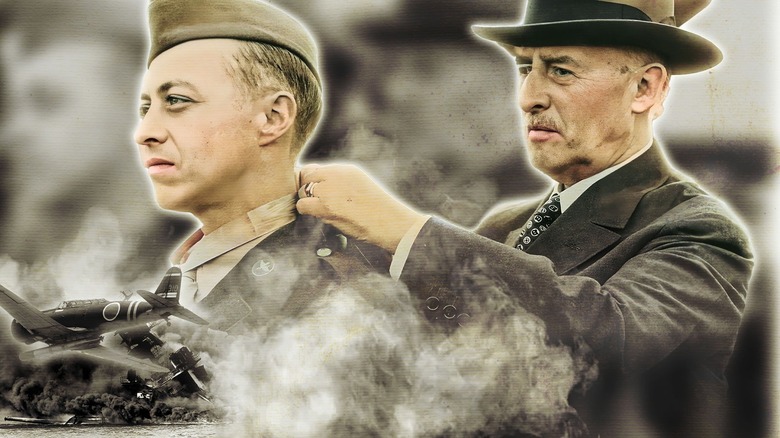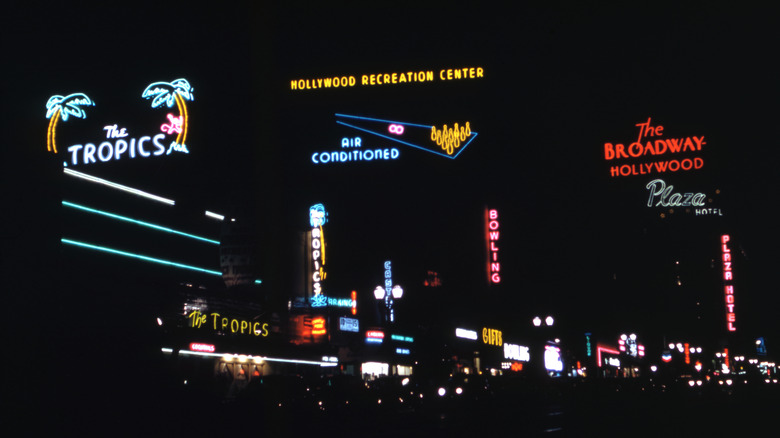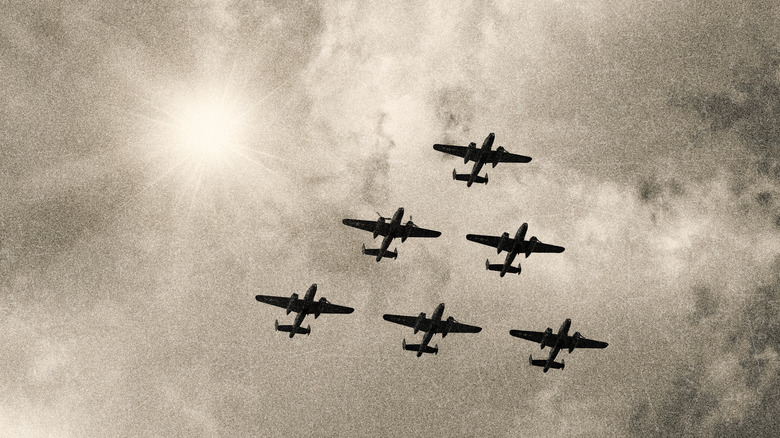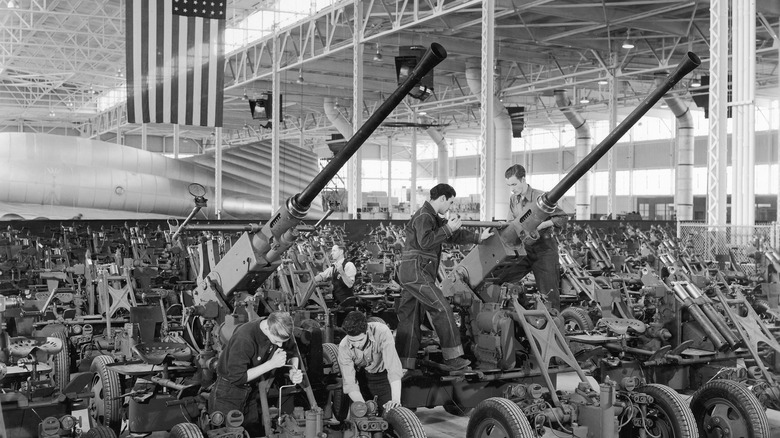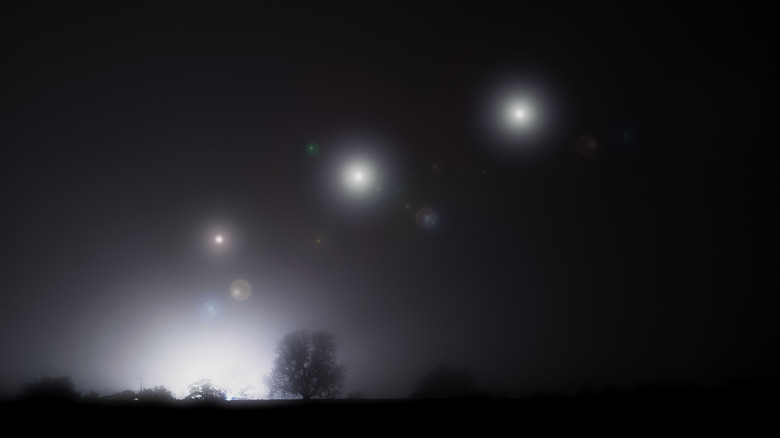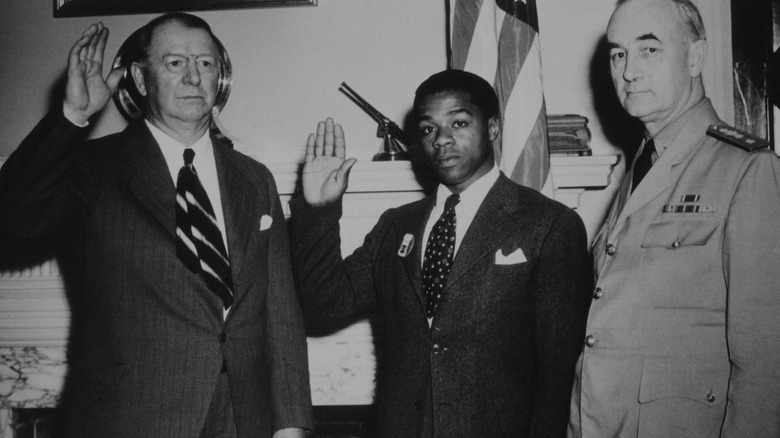Things That Don't Make Sense About World War II's Battle Of Los Angeles
Some folks might be able to name a few prominent World War II battles off the top of their heads. There's the Battle of Dunkirk, where naval and civilian ships rescued Allied soldiers from northern France. The Battle of Normandy featured Allied forces taking French beaches on the now-legendary D-Day. Then there's the war in the Pacific that produced the Battles of Midway, Iwo Jima, and Okinawa. And of course, there's the Battle of Los Angeles, which wasn't a battle at all but gave us a pretty die-cast 2011 film featuring the shakiest of shaky cams, soldiers vs. aliens, and pew-pew shootouts.
So no, there's not a lot about the Battle of Los Angeles — "battle" in quotes — that makes sense. More accurately called the Delusion of Los Angeles or the Tale of Jumpin' the Gun, the incident saw the U.S. Army's Coast Artillery Brigade pulverize the bare and empty sky with "ack-ack fire" on February 25, 1942, per History. Reports came in about weird lights, or UFOs, or phantom planes, or a "big floating object resembling a balloon," or ... Yeah, it isn't quite clear. The military jumped (and shot) the gun from 2:15 a.m. to 4:00 a.m., wasting about 1,400 shells firing at nothing.
Per the Warfare History Network, Secretary of the Navy Frank Knox called the whole thing "war nerves." Pearl Harbor had happened only about three months prior, and people were paranoid. Nonetheless, the military's response seemed strangely overblown, sudden, prolonged, and irrational. It still doesn't make sense to this day.
Blasting the sky without confirmation
Let's do a little thought experiment here: Imagine you're alone in your house and you think you hear a noise in the kitchen. Do you cautiously go and see what it is before deciding on a subsequent course of action, or bust out about 10,000 guns and repeatedly blast into the darkened kitchen for about 105 minutes straight without stopping once to check if you hit anything inside? If you chose the latter, then congratulations: You have the decision-making skills of the Army personnel responsible for attacking the atmosphere above Los Angeles on February 25, 1942.
Granted, reports do indicate that military radar saw ... something(?) poking around in the air about 120 miles west of Los Angeles on the night in question. This happened around 2 a.m.. What was it? No clue. How big was it? No idea. Were there more than one? Yes and/or no. Did any fighter planes go out to investigate? Nope. Did anyone confirm the imminent, existential threat terrorizing the skies above Los Angeles? Apparently not.
We mentioned Secretary of the Navy Frank Knox's "war nerves" excuse. It really does seem like the public and military were so, so freaked out by Pearl Harbor and subsequent false reports of further attacks in New York that they shot first, asked questions later. Civilians were told to be prepared — air raids would blare. Pilots and radar technicians had even mistaken fishing boats off the coast for enemy vessels in prior weeks.
False sightings of UFOs, paratroopers, and planes
And so we come to the most beloved-by-conspiracy-lovers bit of strangeness about the Battle of Los Angeles: aliens. After all, what else could appear on radar, be flattened by an endless barrage of American military muscle, and then not exist? That's some logic right there.
Depending on the report, eyewitnesses described anything from a "bell-shaped to an oblong or round object that measured anywhere from 16 to 80 feet" moving 200 mph, per Warfare History Network. Citizens of Los Angeles, meanwhile, called in reports of Japanese paratroopers diving out of squadrons of planes. On the military side of things, artilleryman Charles Patrick described what he saw in a letter, per History. "I could see six planes, and shells were bursting all around them," he wrote. "Naturally, all of us fellows were anxious to get our two-cents' worth in and, when the command came, everybody cheered like a son of a gun." But as we know, nothing was there.
In fact, the only things to fall from the sky were artillery shell fragments. Shrapel showered Los Angeles and destroyed homes. Three people died in car crashes while driving around in the hysteria (the city was put under a blackout). Two people died from heart attacks. Exploding shells in the sky only added to the confusion and sightings of mysterious lights, objects, etc. Per History.com, Coastal Artillery Corps Colonel John G. Murphy later said, "Imagination could have easily disclosed many shapes in the sky in the midst of that weird symphony of noise and color."
Gunfire continued for over an hour and a half
We mentioned the U.S. Army's Coast Artillery Brigade firing into the sky without confirmation of an enemy target. But the sheer length of time they fired into the sky remains baffling. Two minutes of artillery fire before someone waves their hands around and yells, "False alarm, false alarm"? We could see that. But over an hour and a half nonstop without anyone pulling the plug? It's frankly absurd.
According to Warfare History Network, there's one potential explanation for the military's weird failure to cease-fire: An order apparently did come down the pipe for troops to stop shooting, but there were "difficulties in communication" preventing the directive from being transmitted. For over 90 minutes, mind. And yet, U.S. Secretary of War Henry L. Stimson doubled down at the time. "It is better to be too alert than not alert enough," he said, per the Los Angeles Times. He also tried to cover for himself and others by saying that even though there were no Japanese planes in the sky, there were other planes flown by "enemy agents" that had infiltrated Los Angeles airspace. He said there were 15 of these.
Others, like the Los Angeles county sheriff, hung their heads in rightful embarrassment. As the Los Angeles Times wrote of the sheriff in 1992, "He had valiantly helped the FBI round up several Japanese nurserymen and gardeners who were supposedly caught in the act of signaling the enemy aviators."
No planes were dispatched to the scene
We mentioned how strange it was that the Army didn't confirm the existence of the supposed enemy aircraft either before or while firing 1,400 anti-aircraft artillery rounds into the sky. Granted, radar is the first line of defense against enemy aircraft, and we know that the Army claimed to see something on radar 120 miles west of Los Angeles about 2 a.m. on the night of the Battle of Los Angeles. The technology had proven its worth to the U.S. at Pearl Harbor if only because it was new — things turned disastrous because personnel didn't understand its value when it detected Japanese planes en route. But to completely rely on radar a mere three months later and not use planes at all? That's strange.
So no, not one single plane was sent to view, confirm, attack, or pursue the enemy on February 25, 1942. Yes, it was dark, but there were spotlights on the ground to help see the sky. No, U.S. planes couldn't enter the firing area of the anti-aircraft guns, but they could circle around and stay out of range. Yes, anti-aircraft artillery was probably the fastest response. But, the attack also persisted till 4 a.m., which could've given U.S. aircraft time to arrive on the scene. Yes, a dogfight above a city could have been dangerous for civilians below, but if enemy aircraft were going to get shot and rain shrapnel and debris onto the city, then what's the difference? The latter happened, anyway, minus the enemy aircraft.
The lame military explanation
We mentioned some of the, "Meh, what are you gonna do?" statements made by folks like U.S. Secretary of War Henry L. Stimson following the Battle of Los Angeles. It resulted in at least five American deaths that wouldn't have happened without the whole fiasco — and not a single enemy combatant killed, to boot. But such "better safe than sorry" rationale fails considering all of the strange elements we mentioned in this article: the magnitude of the attack, the length of it, the lack of even the barest attempt to double-check radar via another means, and so forth. And finally, the Army's post hoc analysis of the situation proved equally lame.
As reported by History, after the night in question, the Army's Western Defense Command stated matter-of-factly (and without apology), "Although reports were conflicting and every effort is being made to ascertain the facts, it is clear that no bombs were dropped and no planes were shot down." In 1992, the Los Angeles Times described an Army report of the Battle of Los Angeles boiling the flub down to three factors: weather balloons released above Los Angeles on the night in question, those balloons carrying lights that ground personnel took for Japanese planes, and "shell bursts illuminated by searchlights" also taken for enemy aircraft. If this is true, then a simple fix would be informing the military whenever weather balloons hit the sky. Also: Not everything with a reflective surface or light is a Japanese warplane.
